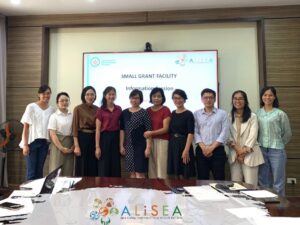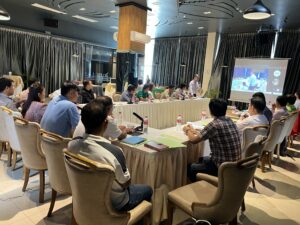A total of 51 ALiSEA members took part in the ALiSEA 2023 Small Grant Facility Information and proposal-writing session held from August 15 -17, 2023 in each country: Vietnam, Laos and Cambodia.
The objective was to help ALiSEA members have a clear understanding of the call for proposal process and to strengthen the development of ALiSEA members’ proposal writing skills.
- In Vietnam
- In Laos
- In Cambodia
Presentations from the information and proposal-writing sessions are available to download below:
ο ALiSEA SMALL GRANT FACILITY: Overview – Information Session
ο SMALL GRANT FACILITY: Proposal writing Session
Kindly find hereafter a wrap up of all the feedbacks and answers provided during the different sessions:
Information Session
A. Small Grant Topics and Activities
Q: How can young farmers should be identified to take part in the project implementation? Are there any criteria? Who should be targeted for example students? jobless young people?
A: Youth refers to the young people who are involved in agroecology such young farmers, students, interns. Based on FAO, the term ‘youth’ applies to people under the age of 35. However, there are no fixed criteria as part of these guidelines. It is flexible according to your knowledge of the context.
Q: Are there any links between Topic number 1 and 3? For example, fostering synergies by supporting young farmers for better access to market.
A: Yes, the proposal can include activities related to topic N1 and N3. However, the proposal should define which topic is the main focus of attention.
Q: Is it possible for a proposal to be submitted to implement a part of ASSET’s work?
A: The objective of the small grant is to support ALiSEA members on their own intervention areas and work. All provinces are eligible.
B. Expected outputs
Q: Are the expected outputs the same for each topic?
A: Yes, all topics are expected to provide the same outputs. The list is provided below:
ο Produce one case study report following a specific template;
ο Brief narrative and financial report will be expected (template for this will also be provided);
ο Develop at least two knowledge products to capture the approach, the lessons learned and results of the grant. For this, the format is more flexible and shall be relevant to topic of the small grant: it could be additional case studies reports, policy paper, video, communication to conferences, etc.;
ο Participate in at least two lesson-sharing and cross-learning events (webinar, exchange visit etc.) as part of the Small Grant Monitoring Process.
C. Budget
Q: Does the co-funding budget have to be mentioned in the full proposal?
A: Yes, it should be mentioned in the full proposal, in word format.
Q: Local NGOs and farmer organizations are concerned about the final 30% payment. They don’t have a sufficient budget to implement the project to completion. Can ALiSEA change this requirement to 5 or 10%?
A: The payment modalities have been agreed by all partners and donors. However, the ALiSEA team takes note and will discuss this point with donors.
Q: Who is responsible for paying taxes?
A: The applicant responds on tax payment, VAT or salary tax.
Q: Can applicants claim VAT taxes?
A: VAT Taxes are not eligible costs IF it is recoverable by your organization. Please refer to page 7 of the Small Grant Guidelines.
Q: Can the staff budget line be used for only one staff’s salary (such as the project manager) within the maximum amount 40% limit?
A: The 40% of the budget for staff cost covers all staffs involved in the project. The detailed budget must reflect the team composition that will be involved in implementing the activities. In addition, timesheet and salary slip will be requested as supporting documents.
Q: Where should we allocate transportation expenses for the participants who join the workshop/activities?
A: Transportation expenses should be allocated to Section C “Local transport costs section” referring to the travel cost (gasoline, bus, vehicle rental etc.)
Q: Does the exchange rate correlate with the bank’s daily rate?
A: There are two options:
ο The grantee may apply its own exchange rate policy (which could be daily, monthly bank rate or other if this complies with the conditions mentioned in the article 11.3 of the Grant Agreement)
ο The grantee can apply the exchange rate used for its real transaction of exchange
Q: What are the rules for the per diem payment?
A: The applicant can use its own per diem rate policy. The applicant should apply and follow the government rules on per diem while involving and inviting government officers.
Q: How are the cost norms applied in the proposal?
A: The cost norm shall be applied according to the applicant’s regulations.
D. Application
Q: Small grant is eligible for members who have six months of seniority in the ALiSEA Network. Is there any exceptions for new members who have less than 6 months seniority?
A: There are no exceptions for members who have less than 6 months’ seniority. However, the proposal requires a minimum of one co-applicant. Thus, any members who have joined ALiSEA for less than 6 months can join as the co-applicant.
Q: Can the co-application and lead applicant intervene in different areas?
A: Both applicants are required to implement activities in the same area.
Q: Who can be a co-applicant?
A: The co-applicant can be ALiSEA members or non-members, any kind of stakeholders such as NGO, farmers’ organization, private sector organization, network, research center, universities. However, the co-applicants cannot be individuals.
Q: What are the differences in responsibilities between the lead applicant and co-applicant?
A: The lead applicant submits all required documents, prepares narrative reports and financial reports, directs management, and communicates with donors. The co-applicant contributes to the proposal development and implementation of activities.
Q: In a case where the lead applicant cannot find a co-applicant who participates in the same area, does ALiSEA allow an exception for this proposal without a co-applicant?
A: No, there is no exception for this case. It is compulsory that applicants must apply via a consortium. A minimum of two applicants is required. The main objective of the small grants are:
ο To strengthen partnerships between the ALiSEA members and encourage joint actions;
ο To reinforce members’ skills through building partnership with non-members;
ο To broaden the network efforts of inclusiveness, representativeness of the variety of stakeholders in agriculture and food systems.
However, the lead and co-applicants can be based in different areas or provinces or countries, but they are required to implement the proposed project activities in the same area.
Q: Are non-members as co-applicants taking advantage of member?
A: No, the objective is to foster and encourage partnerships with relevant stakeholders, but also broadening the network, while giving opportunity for non-members to become ALiSEA member.
Q: Can an ALiSEA member and a non-member of ALiSEA submit a joint proposal?
A: Yes. The ALiSEA member shall apply as the lead applicant and the non-member as co-applicant. The lead applicant shall submit the proposal.
E. Administrative Information
Q: For the organization’s administrative information section, who should provide this information, the lead applicant or co-applicant?
A: The lead applicant should provide this information.
Q: Is there any available template for consortium agreement between the lead and co-applicant?
A: No fixed template is provided; both parties can make a simple agreement to work together. If needed, ALiSEA team can provide examples.
Q: Is there a difference between active members or inactive members in the application process?
A: No. There is no definition of active or inactive members.
Proposal writing Session
Full Proposal
Q: There are 3 topics for 2023, how can we know about all the proposed activities related to agroecology?
A: You can check and compare your proposed activities with the 13 principles of agroecology.
Q: Do we need to answer and explain all 13 Principles of Agroecology?
A: No, you don’t have answer to all 13 Principles. You must explain the principles that are covered by your proposal, and explain how activities in the proposal are contributing to some of the 13 Principles of Agroecology.
Q: What does Gender issue mean?
A: This refers to the aspects and concerns of women and men in agriculture, such as access to resources, decision making etc. The project activities should foster men and women equality.
Q: Is there a limit number of words in the activity section?
A: No, there is no limit number of words or lines, but the applicant has to remember the length of the full proposal cannot exceed 10 pages.
Q: What are some examples of the knowledge products?
A: The knowledge products can be videos, case studies, successful stories, podcasts, posters, policy briefs or position papers.
Q: What kind of experiences should be highlighted in the proposal?
A: We recommend that applicants highlight their past experiences of project implementation related to agroecology.
Additional comments for future calls,
ο It is suggested that an assessment of the organizations’ track record be carried out prior to selection, in order to reduce the risk of financial mismanagement.
ο It is suggested to provide financial and administrative management training to selected organizations.



